Predictive Capacity of Rainfall Data to Estimate the Water Needs of Fruit Plants in Water Deficit Areas
Abstract
1. Introduction
2. Materials and Methods
2.1. Experimental Site and Weather Conditions
2.2. Water Needs of Fruit Trees Calculated by Press
2.3. Water Needs of Fruit Trees According to the Method of Rzekanowski and Grabarczyk
2.4. Water Needs of Fruit Trees Calculated Using the Treder Method
- Estimation of the reference evapotranspiration (ETo) that were made according to the formula Equation (3):where: ETo = reference evapotranspiration (mm); α = empirically determined plant coefficient; T = average temperature on the given day (°C), calculated using the following formula Equation (4):where: T = average temperature on the given day (°C); Tmin = minimum temperature (°C); Tmax = maximum temperature (°C).
- Estimation of the evapotranspiration of a specific species (ETr) that were made according to the formula Equation (5):where: ETp = potential evapotranspiration for a specific species (mm); kc = plant coefcient, assumed for a specific species and month (Table 2); ETo = reference evapotranspiration.
- Estimation of the evapotranspiration of a specific planting, taking into account tree sizes (ETr*) that were made according to the formula Equation (6):where: ETr* = evapotranspiration of a specific planting, taking into account tree sizes; wp = correction coefficient, read from the diagram based on the shading of the ground by the tree crowns (%). The correction coefficient (wp) increases along with the increase of the shading of the ground by tree crowns. For example: for shading equal to 10%, 20%, 30%, 40%, 50% and 60%, the wp coefficient is about 28%, 48%, 65%, 80%, 90% and 98%, respectively; ETp = potential evapotranspiration for a specific species (mm).
3. Results and Discussion
3.1. Water Needs of Fruit Trees Calculated by Press Method
3.2. Water Needs of Fruit Trees According to the Method of Rzekanowski and Grabarczyk
3.3. Water Needs of Fruit Trees Calculated Using the Treders Method
3.4. Comparison of the Methods Used to Calculate the Water Needs of Fruit Trees
4. Conclusions
Author Contributions
Funding
Institutional Review Board Statement
Informed Consent Statement
Data Availability Statement
Conflicts of Interest
References
- Kuchar, L.; Iwański, S. Symulacja opadów atmosferycznych dla oceny potrzeb nawodnień roślin w perspektywie oczekiwanych zmian klimatycznych [Rainfall simulation for the prediction of crop irrigation in future climate]. Infrastruct. Ecol. Rural Areas 2011, 5, 7–18. [Google Scholar]
- Koźmiński, C.; Michalska, B. Atlas Uwilgotnienia Gleby pod Roślinami Uprawnymi w Polsce [Atlas of Soil Moisture under Arable Crops in Poland]; Akademia Rolnicza: Szczecin, Poland, 1995; p. 56. [Google Scholar]
- Banaszak, J. Stepowienie Wielkopolski pół Wieku Później [Steppe Development in Wielkopolska Half a Century Later]; Akademia Bydgoska: Bydgoszcz, Poland, 2003; p. 266. [Google Scholar]
- Łabędzki, L. Przewidywane zmiany klimatyczne a rozwój nawodnień w Polsce [Foreseen climate changes and irrigation development in Poland]. Infrastruct. Ecol. Rural Areas 2009, 3, 7–18. [Google Scholar]
- Parry, M.L.; Canziani, O.F.; Palutikof, J.P.; van der Linden, P.J.; Hanson, C.E. Climate Change 2007: Impacts, Adaptation and Vulnerability. Contribution of Working Group II to the Fourth Assessment Report of the Intergovernmental Panel on Climate Change; Cambridge University Press: Cambridge, UK, 2007; p. 976. [Google Scholar]
- Lobell, D.B.; Burke, M.B.; Tebaldi, C.; Mastrandrea, M.D.; Falcon, W.P.; Naylor, R.L. Prioritizing climate change adaptation needs for food security in 2030. Science 2008, 319, 607–610. [Google Scholar] [CrossRef]
- Pérez-Pastor, A.; Ruiz-Sánchez, M.C.; Martínez, J.A.; Nortes, P.A.; Artés, F.; Domingo, F. Effect of deficit irrigation on apricot fruit quality at harvest and during storage. J. Sci. Food Agric. 2007, 87, 2409–2415. [Google Scholar] [CrossRef]
- Treder, W.; Klamkowski, K.; Krzewińska, D.; Tryngiel-Gać, A. Najnowsze trendy w nawadnianiu upraw sadowniczych—Prace badawcze związane z nawadnianiem roślin prowadzone w ISK w Skierniewicach [The latest trends in irrigation technology—Research related to irrigation of fruit crops conducted at the research institute of pomology and floriculture in Skierniewice]. Infrastruct. Ecol. Rural Areas 2009, 6, 95–107. [Google Scholar]
- Słowik, K. Wpływ nawadniania i nawożenia na wzrost i owocowanie roślin sadowniczych [Influence of irrigation and fertilization on the growth and fruiting of fruit plants]. Zesz. Probl. Postęp. Nauk Rol. 1973, 2, 59–67. [Google Scholar]
- Hołubowicz, R.; Tylkowska, K.; Gruchała, L. Ethylene production as a biochemical marker for radish seed vigour. Folia Hortic. 1993, 5, 19–28. [Google Scholar]
- Treder, W.; Wójcik, K.; Tryngiel-Gać, A.; Krzewińska, D.; Klamkowski, K. Rozwój nawodnień roślin sadowniczych w świetle badań ankietowych [Development of irrigation of orchard plants reflected by survey investigations]. Infrastruct. Ecol. Rural Areas 2011, 5, 61–69. [Google Scholar]
- Żarski, J.; Dudek, S. Zmienność czasowa potrzeb nawadniania wybranych roślin w regionie Bydgoszczy [Time variability of selected plants irrigation needs in the region of Bydgoszcz]. Infrastruct. Ecol. Rural Areas 2009, 3, 141–149. [Google Scholar]
- Treder, W.; Konopacki, P. Impact of quantity and intensity of rainfall on soil water content in an orchard located in the central part of Poland. J. Water Land Dev. 1999, 3, 47–58. [Google Scholar]
- Ziernicka-Wojtaszek, A.; Zuśka, Z.; Piskulak, P. Potrzeby opadowe roślin uprawnych w aspekcie współczesnych zmian klimatu [Precipitation requirements of cultivated plants in the aspect of contemporary climate change]. Infrastruct. Ecol. Rural Areas 2015, III/1, 507–514. [Google Scholar]
- Ballif, J.L. Runoff water and infiltration of a viticultural soil in Champagne. Results of mulching with municipal compost and crushed bark 1985–1994. Progres Agricole Viticole 1995, 112, 534–544. [Google Scholar]
- Treder, W.; Klamkowski, K.; Wójcik, K. A new approach to the method of drawing the Gaussen-Walter climate diagram. Meteorol. Hydrol. Water Manag. 2018, 6, 1–7. [Google Scholar] [CrossRef]
- Drupka, S. Nawodnienia deszczowniane i kroplowe [Irrigation and drip irrigation]. In Podstawy Melioracji Rolnych [Basics of Agricultural Melioration]; Prochala, P., Ed.; PWRiL: Warszawa, Poland, 1986; pp. 449–620. [Google Scholar]
- Bac, S.; Rojek, M. Meteorologia i Klimatologia [Meteorology and Climatology]; PWN: Warszawa, Poland, 1979. [Google Scholar]
- Święcicki, C. Gleboznawstwo Melioracyjne [Soil Science of Melioration]; PWN: Warszawa, Poland, 1981; pp. 218–228. [Google Scholar]
- Drupka, S. Techniczna i Rolnicza Eksploatacja Deszczowni [Technical and Agricultural Operation of the Sprinkler]; PWRiL: Warszawa, Poland, 1976; pp. 103–122. [Google Scholar]
- Rzekanowski, C.; Żarski, J.; Rolbiecki, S. Potrzeby, efekty i perspektywy nawadniania roślin na obszarach szczególnie deficytowych w wodę [Requirements, results and perspectives of plant irrigation on the areas characterized by distinct water deficits]. Postęp. Nauk Rol. 2011, 1, 51–63. [Google Scholar]
- Doorenbos, J.; Pruitt, W.O. Guidelines for predicting crop water requirements. FAO Irrig. Drain. Pap. 1977, 24, 176. [Google Scholar]
- Xing, Z.; Chow, L.; Meng, F.R.; Res, H.W.; Stevens, L.; Monteith, L. Validating evapotranspiration equations using Bowen Ratio in New Brunswick. Maritime Canada. Sensors 2008, 8, 412–428. [Google Scholar] [CrossRef] [PubMed]
- Treder, W.; Wójcik, K.; Żarski, J. Wstępna ocena możliwości szacowania potrzeb wodnych roślin na podstawie prostych pomiarów meteorologicznych [Preliminary assessment of the possibility of estimating water requirements of plants on the basis of simple meteorological measurements]. Zesz. Nauk. Inst. Sadow. Kwiac. 2010, 18, 143–153. [Google Scholar]
- Żakowicz, S.; Hewelke, P.; Gnatowski, T. Podstawy Infrastruktury Technicznej w Przestrzeni Rolniczej [Fundamentals of Technical Infrastructure in Agricultural Space]; SGGW: Warszawa, Poland, 2009; pp. 1–192. [Google Scholar]
- Rzekanowski, C. Perspektywy rozwoju nawodnień w Polsce. Wiad. Melior. Łąk. 2010, 2, 55–58. [Google Scholar]
- Łabędzki, L.; Kanecka-Geszke, E.; Bąk, B.; Słowińska, S. Estimation of reference evapotranspiration using the FAO Penman-Monteith method for climatic conditions of Poland. In Evapotranspiration; Łabędzki, L., Ed.; InTech: Rijeka, Croatia, 2011; pp. 1–446. [Google Scholar]
- Żarski, J. Tendencje zmian klimatycznych wskaźników potrzeb nawadniania roślin w rejonie Bydgoszczy [Trends in changes of climatic indices for irrigation needs of plants in the region of Bydgoszcz]. Infrastruct. Ecol. Rural Areas 2011, 5, 29–37. [Google Scholar]
- Kundzewicz, Z. Zmiany klimatu, ich przyczyny i skutki—Możliwości przeciwdziałania i adaptacji [Climate change, its causes and impacts. Opportunities for mitigation and adaptation]. Studia BAS 2012, 1, 9–30. [Google Scholar]
- Döll, P. Impact of climate change and variability on irrigation requirements: A global perspective. Clim. Chang. 2002, 54, 269–293. [Google Scholar] [CrossRef]
- Pierzgalski, E.; Jeznach, J. Measures of soil water control in Poland. J. Water Land Dev. 2006, 10, 79–89. [Google Scholar] [CrossRef]
- Hewelke, P. Podstawy regulowania wilgotności gleby za pomocą nawodnień kroplowych [Principles of soil moisture regulation by means of drip irrigation]. Rocz. Glebozn. 1992, 3, 5–18. [Google Scholar]
- Pierzgalski, E.; Jeznach, J. Stan i kierunki rozwoju mikronawodnień [The state and directions of development of micro-hydration]. In Współczesne Problemy Melioracji [Contemporary Problems of Melioration]; Somorowski, C., Ed.; SGGW: Warszawa, Poland, 1993; pp. 35–42. [Google Scholar]
- Rzekanowski, C.; Rolbiecki, S. Efekty produkcyjne stosowania nawodnień kroplowych w regionie bydgoskim [Production effects of the use of drip irrigation in the Bydgoszcz region.]. Przeg. Nauk. Wydz. Melior. Inż. Środ. SGGW Warszawa 1996, 11, 323–329. [Google Scholar]
- Jeznach, J. Aktualne trendy w rozwoju mikronawodnień [Current trends in development of microirrigation]. Infrastruct. Ecol. Rural Areas 2009, 6, 83–94. [Google Scholar]
- Lipiński, J. Analiza stanu nawodnień w Polsce [Analysis of the state of irrigation in Poland]. Wiad. Melior. Łąk. 2010, 2, 51–57. [Google Scholar]
- Nyc, K. Ekonomiczne systemy nawadniające [Economical irrigation systems]. Zesz. Probl. Postęp. Nauk Rol. 1996, 438, 125–132. [Google Scholar]
- Przybyła, C. Ewapotranspiracja rzeczywista w sterowaniu nawodnieniami deszczownianymi [Crop evapotranspiration in sprinkler irrigation control]. Rocz. AR Poznaniu 1994, 257, 255–262. [Google Scholar]
- Payero, J.; Singh, D.; Harris, G.; Vriesema, S.; Hare, J.; Pendergast, L.; Chauhan, Y. Application of a new Web-Based Tool (CropWaterUse) for determining evapotranspiration and irrigation requirements of major crops at three locations in Queensland. In Evapotranspiration; Łabędzki, L., Ed.; InTech: Rijeka, Croatia, 2011; pp. 1–446. [Google Scholar]
- Żarski, J.; Treder, W.; Dudek, S.; Kuśmierek-Tomaszewska, R. Ustalanie terminów nawadniania na podstawie prostych pomiarów meteorologicznych [Establish irrigation deadlines on the basis of simple meteorological measurements]. Infrastruct. Ecol. Rural Areas 2011, 6, 101–108. [Google Scholar]
- Jones, H.G.; Aikman, D.; Mc Burney, T.A. Improvements to infra-red thermometry for irrigation scheduling in humid climate. Acta Hortic. 1996, 449, 259–265. [Google Scholar] [CrossRef]
- Michelakis, N. Daily system radius variation as indicators to optimize olive tree irrigation scheduling. Acta Hortic. 1996, 449, 297–304. [Google Scholar]
- Kaniszewski, S. Nawadnianie Warzyw Polowych [Irrigation of Field Vegetables]; PlantPress: Kraków, Poland, 2005. [Google Scholar]
- Allen, R.G.; Pereira, L.S.; Raes, D.; Smith, M. Crop evapotranspiration—Guidelines for computing crop water requirements. FAO Irrig. Drain. Pap. 1998, 56, 300. [Google Scholar]
- Sentelhas, P.C.; Gillespie, T.J.; Santos, E.A. Evaluation of FAO Penman-Monteith and alternative methods for estimating reference evapotranspiration with missing data in Soutern Ontario, Canada. Agric. Water Manag. 2010, 97, 635–644. [Google Scholar] [CrossRef]
- Grabarczyk, S. Polowe zużycie wody a czynniki meteorologiczne [Field water consumption and meteorological factors]. Zesz. Probl. Postęp. Nauk Rol. 1976, 181, 495–511. [Google Scholar]
- Hargreaves, G.H.; Samani, Z.A. Reference crop evapotranspiration from temperature. Appl. Eng. Agric. 1985, 1, 96–99. [Google Scholar] [CrossRef]
- Droogers, P.; Allen, R.G. Estimating reference evapotranspiration underinaccurate data conditions. Irrig. Drain. Syst. 2002, 16, 33–45. [Google Scholar] [CrossRef]
- Allen, R.G. Penman for all seasons. Proc. ASCE. J. Irrig. Drain. Eng. 1986, 112, 348–368. [Google Scholar] [CrossRef]
- Grabarczyk, S.; Żarski, J. Próba statystycznej weryfikacji niektórych wzorów określających ewapotranspirację potencjalną [An attempt to statistically verify some of the formulas defining potential evapotranspiration]. Zesz. Nauk. ATR Bydgoszcz Rolnictwo 1992, 180, 169–175. [Google Scholar]
- Grabarczyk, S.; Dudek, S.; Grzelak, B.; Peszek, J.; Rzekanowski, C.; Żarski, J. Możliwości produkcyjne gleb bardzo lekkich w warunkach deszczowania [Productive potential of a very light soil under spray irrigation conditions]. Zesz. Probl. Postęp. Nauk. Rol. 1994, 414, 145–152. [Google Scholar]
- Rolbiecki, S. Reakcja trzech gatunków roślin jagodowych uprawianych na glebie bardzo lekkiej na mikronawodnienia [The response of the three berry-bearing species grown on a very light soil to microirrigation]. Zesz. Nauk. ATR Bydgoszczy Rozprawy 2003, 108, 1–87. [Google Scholar]
- Rolbiecki, R. The effect of micro-irrigation on yields of zucchini (Cucurbita pepo L.) cultivated on sandy soil in Central Poland. Acta Hortic. 2007, 729, 325–329. [Google Scholar] [CrossRef]
- Rolbiecki, S.; Rolbiecki, R.; Rzekanowski, C. Nawadnianie jako czynnik przeciwdziałający skutkom posuch w uprawie maliny na glebie piaszczystej [Irrigation as a drought mitigation factor in raspberry cultivation on sandy soil]. Water Environ. Rural Areas 2005, 5, 243–261. [Google Scholar]
- Żarski, J.; Rolbiecki, S.; Dudek, S.; Rolbiecki, R.; Rzekanowski, C. Potrzeby i efekty nawadniania roślin w rejonie Bydgoszczy [Needs and effects of irrigation of plants in the Bydgoszcz region]. In Bilanse Wodne Ekosystemów Rolniczych [Water Balances of Agricultural Ecosystems]; Rojek, M., Ed.; Wydział Inżynierii Kształtowania Środowiska i Geodezji: Wrocław, Poland, 2004; Volume III, pp. 187–203. [Google Scholar]
- Rzekanowski, C. Kształtowanie się potrzeb nawodnieniowych roślin sadowniczych w Polsce [Shaping of irrigation needs for fruit plants in Poland]. Infrastruct. Ecol. Rural Areas 2009, 3, 19–27. [Google Scholar]
- Treder, W.; Jakubiak, B.; Klamkowski, K.; Rudnicki, W.; Kursa, M.; Tryngiel-Gac, A. Prognoza potrzeb wodnych—Internetowa platforma prognozowania potrzeb wodnych roślin sadowniczych zrealizowana w ramach projektu Proza [Water requirement forecast—Internet platform for forecasting fruit crop water needs prepared in the frames of Proza project]. Infrastruct. Ecol. Rural Areas 2013, 2/I, 115–125. [Google Scholar]
- Malicki, L.; Podstawka, E.; Kapusta, B. Rejonizacja potrzeb deszczowania ważniejszych upraw polowych w środkowowschodniej Polsce [Sprinkler irrigation needs of some important crops in the central-eastern Poland]. Zesz. Probl. Postęp. Nauk Rol. 1990, 387, 89–102. [Google Scholar]
- Rojek, M. Potrzeby nawadniania w Polsce [Irrigation needs in Poland]. In Nawadnianie Roślin [Plant Irrigation]; Karczmarczyk, S., Nowak, L., Eds.; PWRiL: Poznań, Poland, 2006; pp. 91–108. [Google Scholar]
- Grabarczyk, S.; Peszek, J.; Rzekanowski, C.; Żarski, J. Rejonizacja potrzeb deszczowania w Krainie Wielkich Dolin [Regionalization of sprinkler irrigation requirements in the zone of big valleys]. Zesz. Probl. Postęp. Nauk. Rol. 1990, 387, 73–88. [Google Scholar]
- Rolbiecki, S. O szacowaniu potrzeb wodnych drzew owocowych w Polsce na podstawie temperatury powietrza [On the estimation of the water needs of fruit trees in Poland based on air temperature]. Infrastruct. Ecol. Rural Areas 2018, II/1, 393–406. [Google Scholar]
- Court, A.; Bare, M.T. Basin precipitation estimates by Bethlahmy’s two-axis method. J. Hydrol. 1984, 68, 149–158. [Google Scholar] [CrossRef]
- Thiessen, A.H. Precipitation averages for large areas. Mon. Weather Rev. 1911, 39, 1082–1089. [Google Scholar] [CrossRef]
- Rolbiecki, S.; Piszczek, P.; Chmura, K. Porównanie potrzeb wodnych wiśni w rejonie Bydgoszczy i Wrocławia [Comparison of sour cherry-tree water requirements in the regions of Bydgoszcz and Wrocław]. Infrastruct. Ecol. Rural Areas 2018, II/1, 349–360. [Google Scholar]
- Grabarczyk, S. Efekty, potrzeby i możliwości nawodnień deszczownianych w rolnych regionach kraju [Productive potential of a very light soil under spray irrigation conditions]. Zesz. Probl. Postęp. Nauk. Rol. 1987, 314, 49–64. [Google Scholar]
- Decision Support System. Internet Platform for Hydration Decision Support. Available online: http://www.nawadnianie.inhort.pl/eto/26-eto-temp (accessed on 1 May 2019).
- Bogawski, P.; Bednorz, W. Comparison and validation of selected evapotranspiration models for conditions in Poland (Central Europe). Water Resour. Manag. 2014, 28, 5021–5038. [Google Scholar] [CrossRef]
- Kielak, Z. Wpływ nawadniania na wzrost i plonowanie wiśni [Influence of irrigation on the growth and yielding of cherries]. Zesz. Probl. Postęp. Nauk Rol. 1986, 268, 611–616. [Google Scholar]
- Bąk, B.; Łabędzki, L. Prediction of precipitation deficit and excess in Bydgoszcz Region in view of predicted climate change. J. Water Land Dev. 2014, 23, 11–19. [Google Scholar] [CrossRef]
- Bąk, B.; Łabędzki, L. Thermal conditions in Bydgoszcz region in growing seasons of 2011–2050 in view of expected climate change. J. Water Land Dev. 2014, 23, 21–29. [Google Scholar] [CrossRef][Green Version]
- Rzekanowski, C. Wpływ nawadniania kroplowego na plonowanie najważniejszych gatunków drzew owocowych w warunkach sadu produkcyjnego [The influence of spray irrigation on the yields of the most important varieties of fruit trees in the production orchard conditions]. Zesz. Nauk. ATR Bydgoszcz Rozprawy 1989, 35, 1–79. [Google Scholar]
- Rolbiecki, S.; Piszczek, P. Effect of the forecast climate change on the sweet cherry tree water requirements in the Bydgoszcz region. Infrastruct. Ecol. Rural Areas 2016, 4, 1559–1568. [Google Scholar]
- Rolbiecki, S.; Piszczek, P. Effect of the forecast climate change on the peach tree water requirements in the Bydgoszcz region. Infrastruct. Ecol. Rural Areas 2016, 4, 1499–1508. [Google Scholar]
- Rolbiecki, S.; Piszczek, P. Effect of the forecast climate change on the plum tree water requirements in the Bydgoszcz region. Infrastruct. Ecol. Rural Areas 2016, 4, 1615–1624. [Google Scholar]
- Rzekanowski, C.; Rolbiecki, S. The influence of drip irrigation on yields of some cultivars of stone fruit-bearing trees in central Poland under different rainfall conditions during the vegetation season. Acta Hortic. 2000, 537, 937–942. [Google Scholar] [CrossRef]
- Treder, W.; Pacholak, E. Nawadnianie roślin sadowniczych [Irrigation of fruit plants]. In Nawadnianie Roślin [Plant Irrigation]; Karczmarczyk, S., Nowak, L., Eds.; PWRiL: Poznań, Poland, 2006; pp. 333–365. [Google Scholar]
- Rolbiecki, S.; Rzekanowski, C. Influence of sprinkler and drip irrigation on the growth and yield of strawberries grown on sandy soils. Acta Hortic. 1997, 439, 669–672. [Google Scholar] [CrossRef]
- Rolbiecki, S.; Rolbiecki, R.; Rzekanowski, C. Response of black currant (Ribes nigrum L.) cv. ‘Titania’ to micro-irrigation under loose sandy soil conditions. Acta Hortic. 2002, 585, 649–652. [Google Scholar] [CrossRef]
- Rolbiecki, S.; Rolbiecki, R.; Rzekanowski, C. Effect of micro-irrigation on the growth and yield of raspberry (Rubus idaeus L.) cv. ‘Polana’ grown in very light soil. Acta Hortic. 2002, 585, 653–657. [Google Scholar] [CrossRef]
- Rolbiecki, R.; Rolbiecki, S. Effects of micro-irrigation systems on lettuce and radish production. Acta Hortic. 2007, 729, 331–335. [Google Scholar] [CrossRef]
- Rolbiecki, R.; Rolbiecki, S. Effect of surface drip irrigation on asparagus cultivars in central Poland. Acta Hortic. 2008, 776, 45–50. [Google Scholar] [CrossRef]
- Stachowski, P.; Markiewicz, J. The need of irrigation in central Poland on the example of Kutno county. Annu. Set Environ. Prot. 2011, 13, 1453–1472. [Google Scholar]


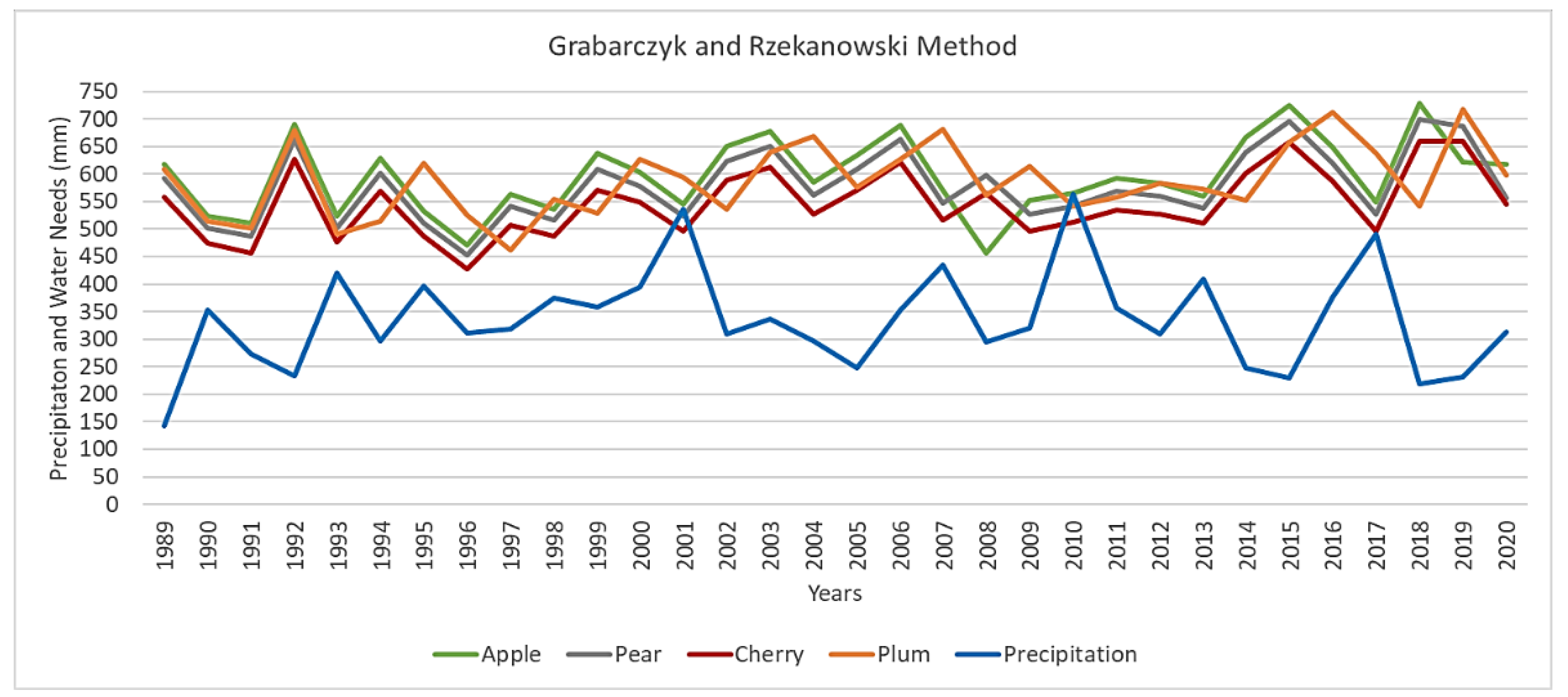
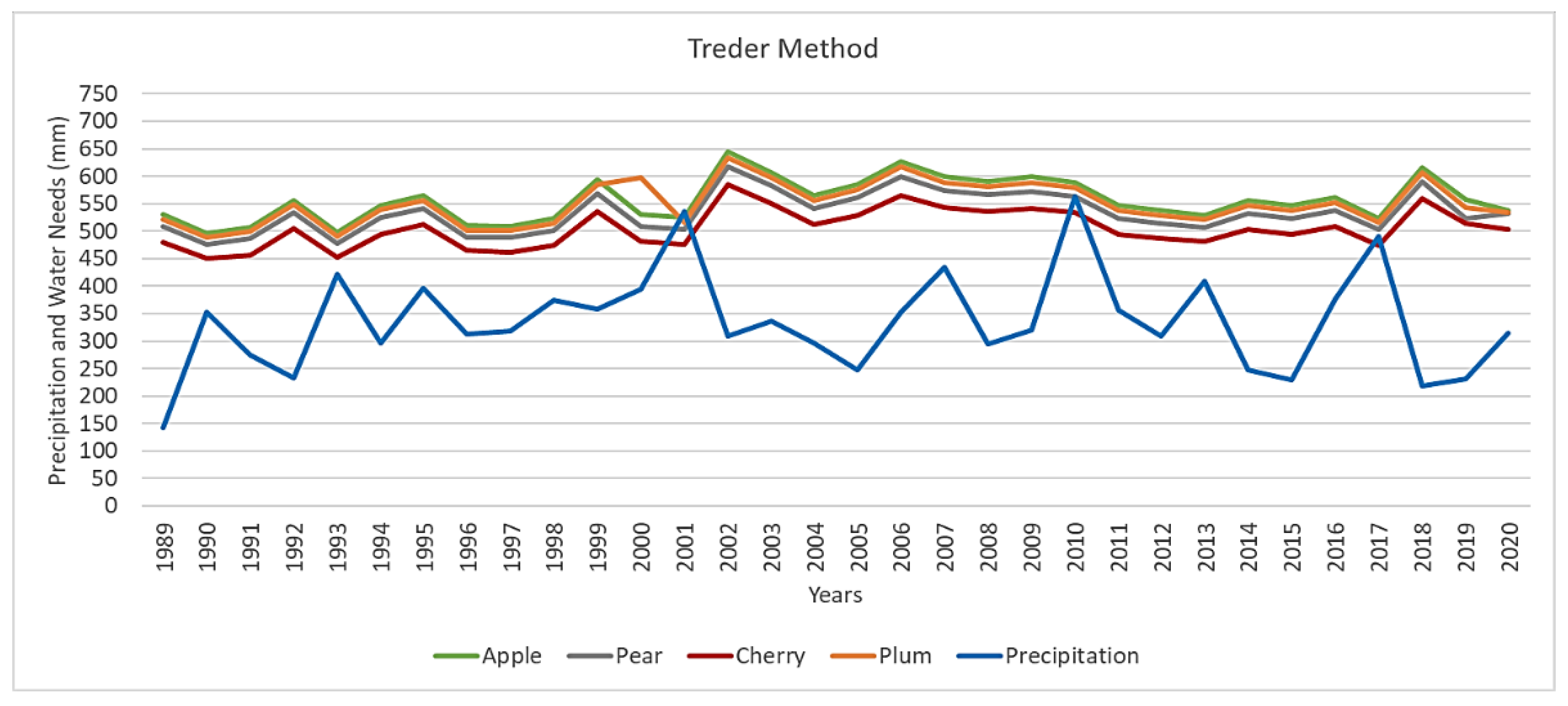
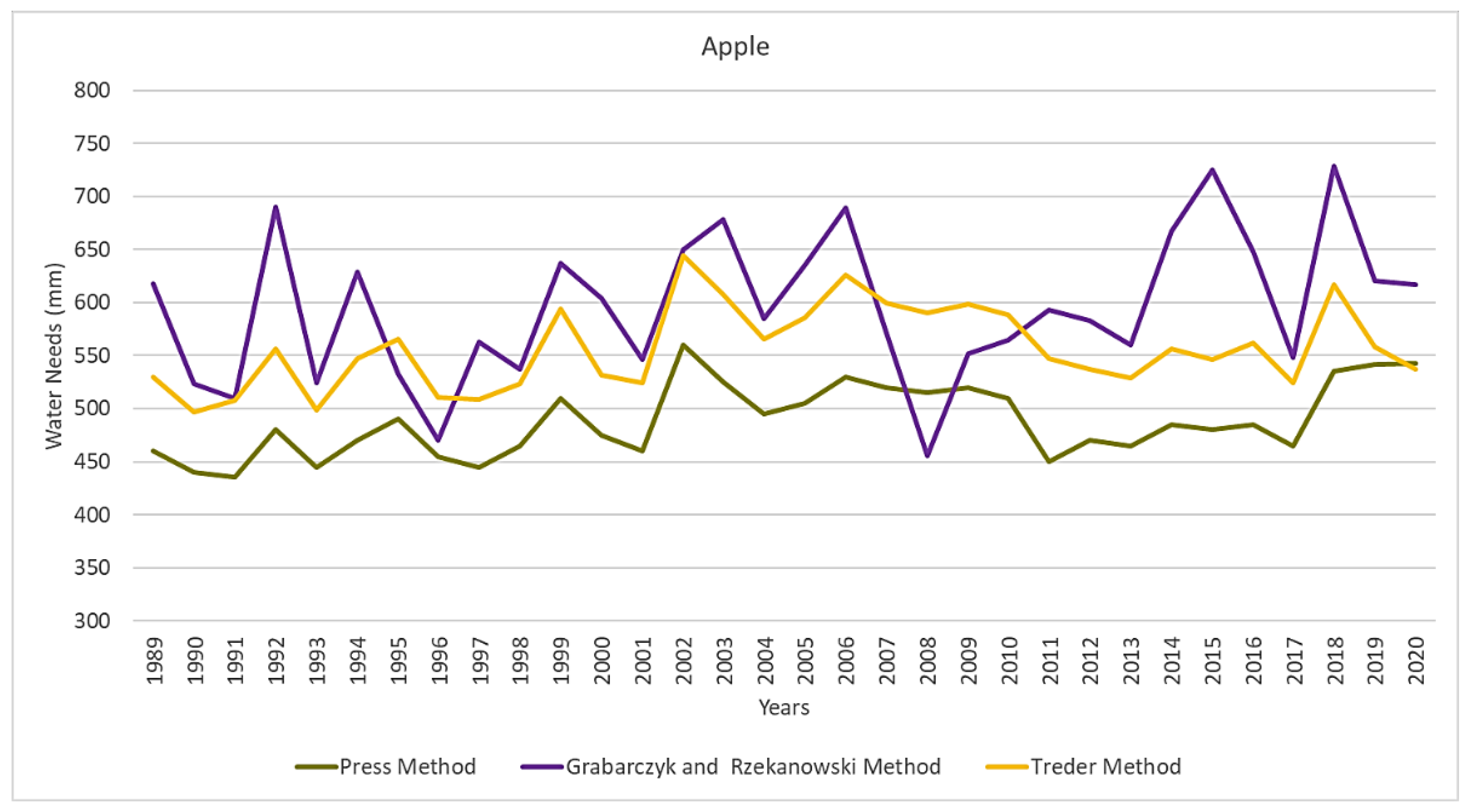

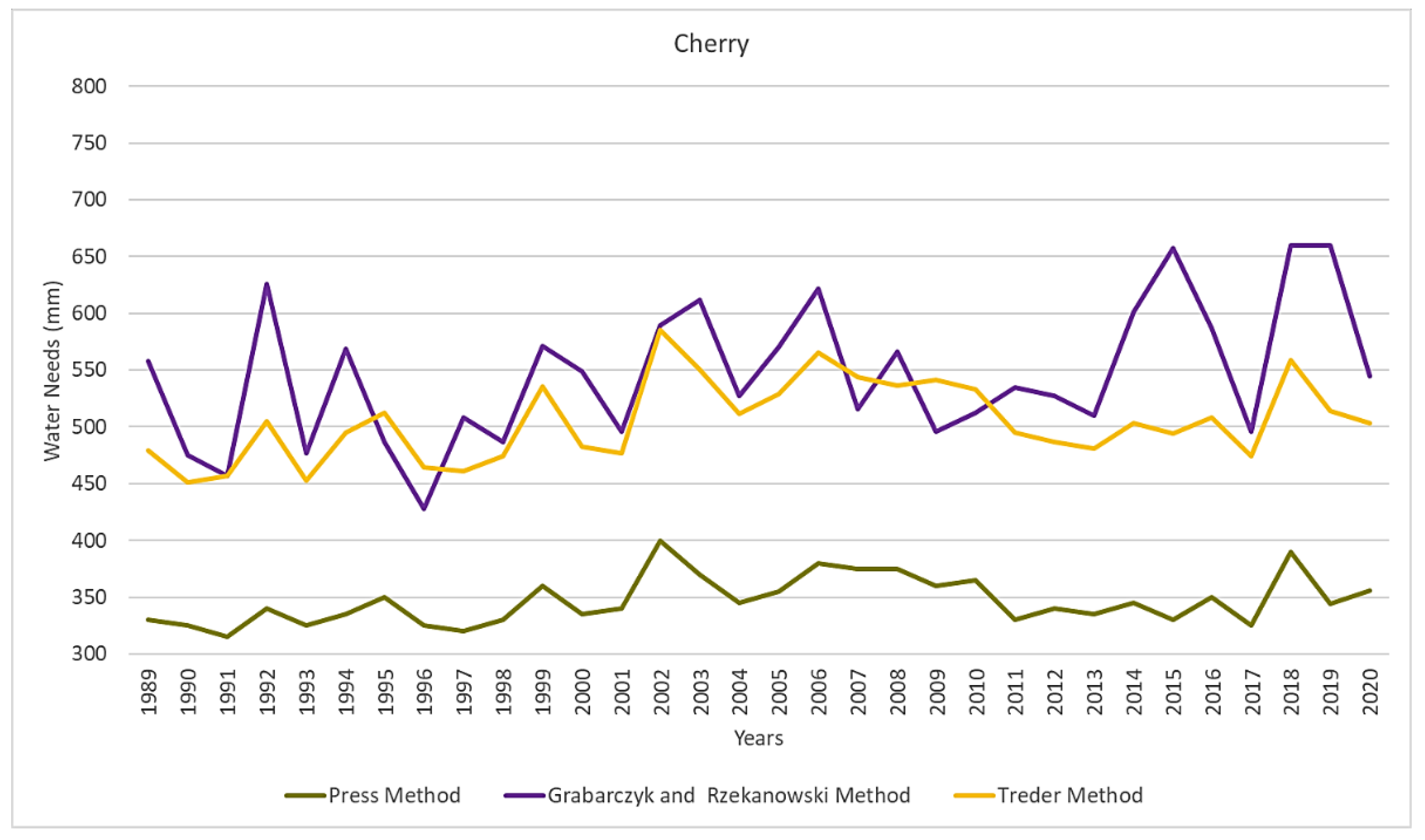
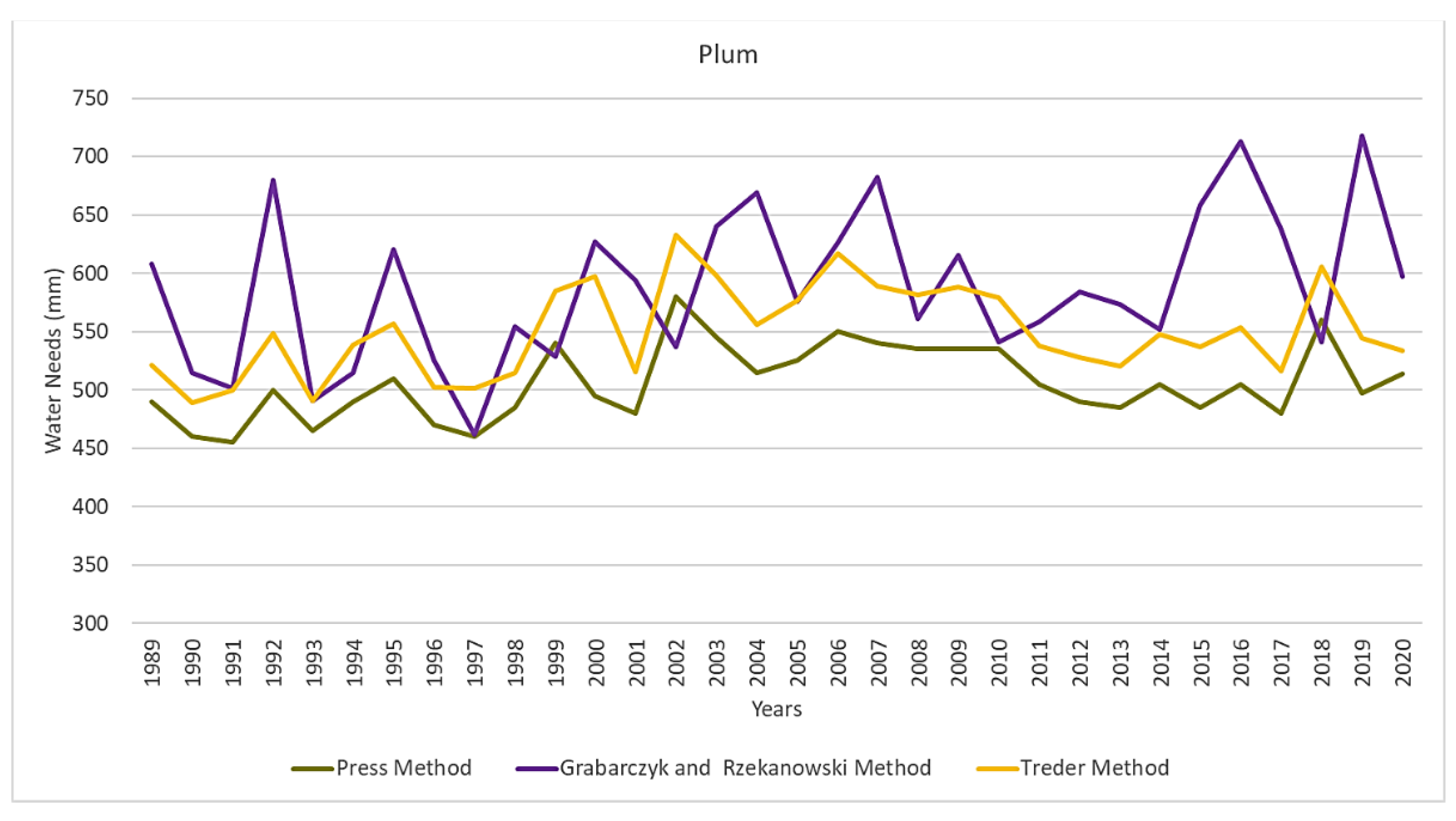

| Period | Plant | Water Needs Range (mm) |
|---|---|---|
| 1 April to 30 September | apple | 380–490 |
| 1 April to 30 September | pear | 325–400 |
| 1 April to 31 August | cherry | 280–345 |
| 1 April to 30 September | plum | 400–510 |
| Month | Empirically Determined Plant Coefficient α | Plant kc Coefficient | |||
|---|---|---|---|---|---|
| Apple | Pear | Cherry | Plum | ||
| April | 0.28 | 0.50 | 0.45 | 0.45 | 0.50 |
| May | 0.21 | 0.75 | 0.75 | 0.75 | 0.75 |
| June | 0.19 | 1.10 | 1.05 | 1.00 | 1.10 |
| July | 0.18 | 1.20 | 1.15 | 1.10 | 1.20 |
| August | 0.17 | 1.20 | 1.15 | 1.10 | 1.20 |
| September | 0.16 | 1.15 | 1.10 | 0.90 | 1.15 |
| Months | Mean (mm) | Standard Deviation (mm) | Variation Coefficient (%) |
|---|---|---|---|
| Apple | |||
| April | 68 | 7.8 | 11.5 |
| May | 78 | 8.1 | 10.3 |
| June | 88 | 8.2 | 9.3 |
| July | 102 | 11.0 | 10.8 |
| August | 94 | 13.2 | 14.1 |
| September | 58 | 4.6 | 8.0 |
| April–September | 488 | 32.1 | 6.6 |
| Pear | |||
| April | 55 | 4.6 | 8.4 |
| May | 69 | 7.8 | 11.3 |
| June | 76 | 4.4 | 5.9 |
| July | 81 | 11.1 | 13.7 |
| August | 68 | 6.4 | 9.4 |
| September | 53 | 5.1 | 9.6 |
| April–September | 398 | 26.5 | 6.6 |
| Cherry | |||
| April | 49 | 5.3 | 10.7 |
| May | 60 | 8.0 | 13.4 |
| June | 76 | 4.8 | 6.3 |
| July | 90 | 10.6 | 11.8 |
| August | 73 | 5.8 | 7.9 |
| April–August | 347 | 22.1 | 6.3 |
| Plum | |||
| April | 68 | 8.1 | 11.9 |
| May | 84 | 8.6 | 10.3 |
| June | 93 | 8.6 | 9.3 |
| July | 100 | 10.9 | 10.9 |
| August | 103 | 8.3 | 8.0 |
| September | 57 | 5.7 | 10.1 |
| April–September | 506 | 31.2 | 6.2 |
| Months | Mean (mm) | Standard Deviation (mm) | Variation Coefficient (%) |
|---|---|---|---|
| Apple | |||
| April | 31 | 5.6 | 18.2 |
| May | 70 | 13.2 | 18.8 |
| June | 120 | 19.7 | 16.4 |
| July | 151 | 31.8 | 21.0 |
| August | 144 | 23.8 | 16.5 |
| September | 87 | 18.8 | 21.6 |
| April–September | 603 | 65.4 | 10.8 |
| Pear | |||
| April | 27 | 4.8 | 17.7 |
| May | 71 | 13.4 | 19.0 |
| June | 115 | 18.3 | 15.9 |
| July | 146 | 31.0 | 21.3 |
| August | 139 | 25.6 | 18.4 |
| September | 83 | 17.7 | 21.3 |
| April–September | 580 | 66.4 | 11.5 |
| Cherry | |||
| April | 27 | 5.0 | 18.1 |
| May | 71 | 13.8 | 19.4 |
| June | 110 | 17.7 | 16.1 |
| July | 139 | 29.1 | 21.0 |
| August | 134 | 25.6 | 19.2 |
| September | 68 | 14.7 | 21.6 |
| April–September | 548 | 61.9 | 11.3 |
| Plum | |||
| April | 28 | 5.4 | 19.4 |
| May | 70 | 13.4 | 19.0 |
| June | 120 | 19.5 | 16.3 |
| July | 152 | 32.4 | 21.3 |
| August | 138 | 22.9 | 16.6 |
| September | 87 | 18.7 | 21.5 |
| April–September | 595 | 66.7 | 11.2 |
| Months | Mean (mm) | Standard Deviation (mm) | Variation Coefficient (%) |
|---|---|---|---|
| Apple | |||
| April | 39 | 6.1 | 17.1 |
| May | 71 | 8.4 | 11.8 |
| June | 111 | 10.9 | 10.2 |
| July | 133 | 13.8 | 10.8 |
| August | 123 | 10.4 | 8.8 |
| September | 79 | 9.4 | 12.3 |
| April–September | 557 | 39.0 | 7.0 |
| Pear | |||
| April | 36 | 6.1 | 17.1 |
| May | 71 | 8.4 | 11.8 |
| June | 107 | 10.9 | 10.2 |
| July | 128 | 13.8 | 10.8 |
| August | 119 | 10.4 | 8.8 |
| September | 76 | 9.4 | 12.3 |
| April–September | 534 | 37.3 | 7.0 |
| Cherry | |||
| April | 36 | 6.1 | 17.1 |
| May | 71 | 8.4 | 11.8 |
| June | 102 | 10.4 | 10.2 |
| July | 123 | 13.2 | 10.8 |
| August | 113 | 10.0 | 8.8 |
| September | 62 | 7.7 | 12.3 |
| April–September | 505 | 35.1 | 6.9 |
| Plum | |||
| April | 36 | 6.1 | 17.1 |
| May | 71 | 8.4 | 11.8 |
| June | 112 | 11.5 | 10.2 |
| July | 134 | 14.4 | 10.8 |
| August | 119 | 10.4 | 8.8 |
| September | 79 | 9.8 | 12.3 |
| April–September | 550 | 38.3 | 7.0 |
Publisher’s Note: MDPI stays neutral with regard to jurisdictional claims in published maps and institutional affiliations. |
© 2021 by the authors. Licensee MDPI, Basel, Switzerland. This article is an open access article distributed under the terms and conditions of the Creative Commons Attribution (CC BY) license (https://creativecommons.org/licenses/by/4.0/).
Share and Cite
Stachowski, P.; Jagosz, B.; Rolbiecki, S.; Rolbiecki, R. Predictive Capacity of Rainfall Data to Estimate the Water Needs of Fruit Plants in Water Deficit Areas. Atmosphere 2021, 12, 550. https://doi.org/10.3390/atmos12050550
Stachowski P, Jagosz B, Rolbiecki S, Rolbiecki R. Predictive Capacity of Rainfall Data to Estimate the Water Needs of Fruit Plants in Water Deficit Areas. Atmosphere. 2021; 12(5):550. https://doi.org/10.3390/atmos12050550
Chicago/Turabian StyleStachowski, Piotr, Barbara Jagosz, Stanisław Rolbiecki, and Roman Rolbiecki. 2021. "Predictive Capacity of Rainfall Data to Estimate the Water Needs of Fruit Plants in Water Deficit Areas" Atmosphere 12, no. 5: 550. https://doi.org/10.3390/atmos12050550
APA StyleStachowski, P., Jagosz, B., Rolbiecki, S., & Rolbiecki, R. (2021). Predictive Capacity of Rainfall Data to Estimate the Water Needs of Fruit Plants in Water Deficit Areas. Atmosphere, 12(5), 550. https://doi.org/10.3390/atmos12050550









